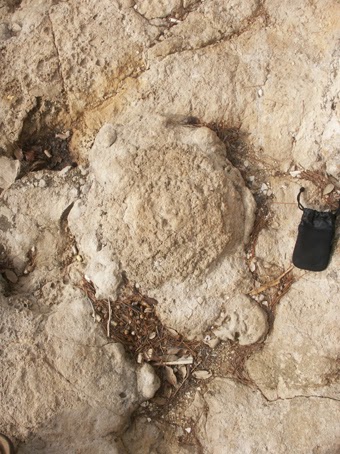Flying saucer's Commander and the medical Doctor examine the cast of the monster's footprint. Their discussion:
DR.: - NO, NO, CAPTAIN, THIS CREATURE RUNS COUNTER TO EVERY KNOWN LAW OF ADAPTIVE EVOLUTION.
COMMANDER (L. Nielsen): - WHAT DO YOU MEAN?
DR.: - NOTICE THIS STRUCTURE HERE? CHARACTERISTIC OF A FOUR-FOOTED ANIMAL. YET, OUR VISITOR OF TONIGHT LEFT THE FOOTPRINTS OF A BIPED. PRIMARILY A GROUND ANIMAL, TOO. IF THIS CLAW CAN ONLY BELONG TO AN ARBOREAL CREATURE, LIKE SOME IMPOSSIBLE TREE SLOTH. JUST DOESN'T FIT INTO A NORMAL NATURE.
BDW (Beri's Dinosaur World): - And yet, the good old doctor was quite wrong in his assumptions regarding the nature of the tracker as well as the nature of the the other real creatures that lived or are living on Earth.
First of all there's no way a footprint would have been preserved in such a detail to enable making a plaster cast of the quality featured in the movie. Second, the depth of the footprint is more related to the substrate material and its consistency than to the size or the weight of the animal. I have seen very deep fossil tracks left by the small dinosaurs and very shallow left by the giant ones. Even if the ID was walking on an ideally prepared clay, taking the foot out of it would deform the footprint's impression.
fact is that the arboreal living sloths have claws much different than the claw on the foot of the ID monster. In fact the sloth claws resemble the claws of a giant dinosaur Therizinosaurus. Here is the left arm of the three-toed sloth (Bradypus). The three-toed sloth's long claws are are adapted to an arboreal life but restrain its mobility on the ground.
Right hand and right foot (with a bit shorter claws) of Bradypus:
The left foot of the extinct giant ground sloth mounted in NHM in London. (Photo credit: B.Krzic)
It looks as if from a biped, but ground sloths were primarily quadrupeds.
Left hand of Bradypus
Note the similarity of the tree sloths hand claws with the long, laterally flattened, slightly curved claws on the right hand (manus) of the giant dinosaur Therizinosaurus:
Source: Wikipedia
Dromaeosaurid killing sickle-claw was also compressed laterally. Here is the right foot of Deinonychus armed with the curved claw on toe #2:
In fact the ID's foot can be defined as a titanosaur sauropod foot armed with the allosaurid finger #1 claw.
Doctor in the movie measured the footprint cats of the monster: 37 INCHES BY 19 (about 90 cm long), quite shy compared to the Early Cretaceous sauropod footprints I have found in Istria: 130 cm long! ID's height = 460 cm.
Here is a rather good, but not quite complete (part of the heel is missing) natural cast of the right foot of the small sauropod (a titanosaur?). You can see the little knobs, impressions of the toes. For size comparison: the little black bag is 13 cm long.
Here is the left footprint cast (130 cm long) of the giant sauropod from the same site. It is almost complete, but the impressions of the toe claws didn't preserve (photo credit: Berislav Krzic)
The ID's footprint cast of the right foot from the movie (below). A peculiar resemblance to the true sauropod track in the photo above (photo credit: Berislav Krzic)
My restoration of the suropod's left foot based on the positive foot impression:
It is interesting to note that some quadruped dinosaurs were facultative bipeds. It's not just that they were capable of rearing up on their hind limbs, like the modern elephants can do, but it seems some were capable of walking or even running in both modes. Here is a paper on one such find:Tracks of a Running Bipedal Baby Brontosaur? Baby Sauropod Footprints Discovered in Colorado - Science Daily
Trivia for the end of this post:It is interesting to note that some quadruped dinosaurs were facultative bipeds. It's not just that they were capable of rearing up on their hind limbs, like the modern elephants can do, but it seems some were capable of walking or even running in both modes. Here is a paper on one such find:Tracks of a Running Bipedal Baby Brontosaur? Baby Sauropod Footprints Discovered in Colorado - Science Daily
The (animated) "big as a house", invisible, indestructible biped monster of ID in a shimmering light from blasters' fire in a climax scene in the movie.
Here is the best model of the ID monster I've seen: Forbidden Planet's ID Monster
It is still not the real thing in my opinion. So, you'd better check out my restoration in the 3rd instalment of this article.













No comments:
Post a Comment